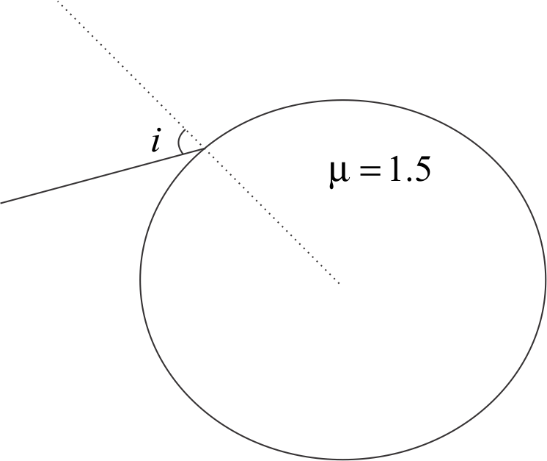
What should be $i$ so that the TIR occurs at the glass air surface.
(A) ${\sin ^{ - 1}}\left( {\dfrac{2}{3}} \right)$
(B) ${\sin ^{ - 1}}\left( {\dfrac{3}{4}} \right)$
(C) ${\sin ^{ - 1}}\left( {\dfrac{1}{2}} \right)$
(D) TIR cannot occur in this situation.

Answer
136.8k+ views
Hint: Total internal reflection takes place at the boundary between two transparent media when a ray of light in a medium of higher index of refraction approaches the other medium at an angle of incidence greater than the critical angle.
Complete step by step solution:
When the angle of incidence in water reaches a certain critical value, the refracted ray lies along the boundary, having an angle of refraction of 90-degrees. This angle of incidence is known as the critical angle; it is the largest angle of incidence for which refraction can still occur. For any angle of incidence greater than the critical angle, light will undergo total internal reflection.
Refractive index ($\mu $), also called index of refraction, measures the bending of a ray of light when passing from one medium into another. Refractive index is also equal to the velocity of light c of a given wavelength in empty space divided by its velocity v in a substance
To find critical angle
${\mu _i}\sin \left( C \right) = {\mu _r}\sin (r)$
Here C =$i$ then that gives r = 90, incident medium is air for it ${\mu _i} = 1$ and
Refraction medium is glass for it ${\mu _r} = 1.5$ (given in the question).
Since light the incident medium is less dense than the refraction medium the condition of TIR is not met. So, in this case there will be no TIR.
Therefore, the correct option is (D).
Note: Total internal reflection (TIR) is the phenomenon that involves the reflection of all the incident light off the boundary. TIR only takes place when both of the following two conditions are met:
1. The light is in the more dense medium and approaching the less dense medium.
2. The angle of incidence is greater than the so-called critical angle.
Complete step by step solution:
When the angle of incidence in water reaches a certain critical value, the refracted ray lies along the boundary, having an angle of refraction of 90-degrees. This angle of incidence is known as the critical angle; it is the largest angle of incidence for which refraction can still occur. For any angle of incidence greater than the critical angle, light will undergo total internal reflection.
Refractive index ($\mu $), also called index of refraction, measures the bending of a ray of light when passing from one medium into another. Refractive index is also equal to the velocity of light c of a given wavelength in empty space divided by its velocity v in a substance
To find critical angle
${\mu _i}\sin \left( C \right) = {\mu _r}\sin (r)$
Here C =$i$ then that gives r = 90, incident medium is air for it ${\mu _i} = 1$ and
Refraction medium is glass for it ${\mu _r} = 1.5$ (given in the question).
Since light the incident medium is less dense than the refraction medium the condition of TIR is not met. So, in this case there will be no TIR.
Therefore, the correct option is (D).
Note: Total internal reflection (TIR) is the phenomenon that involves the reflection of all the incident light off the boundary. TIR only takes place when both of the following two conditions are met:
1. The light is in the more dense medium and approaching the less dense medium.
2. The angle of incidence is greater than the so-called critical angle.
Recently Updated Pages
Uniform Acceleration - Definition, Equation, Examples, and FAQs

JEE Main 2021 July 25 Shift 2 Question Paper with Answer Key

JEE Main 2021 July 25 Shift 1 Question Paper with Answer Key

JEE Main 2021 July 20 Shift 2 Question Paper with Answer Key

JEE Main 2021 July 22 Shift 2 Question Paper with Answer Key

How to find Oxidation Number - Important Concepts for JEE

Trending doubts
JEE Main 2025 Session 2: Application Form (Out), Exam Dates (Released), Eligibility, & More

JEE Main 2025: Derivation of Equation of Trajectory in Physics

Learn About Angle Of Deviation In Prism: JEE Main Physics 2025

Degree of Dissociation and Its Formula With Solved Example for JEE

Formula for number of images formed by two plane mirrors class 12 physics JEE_Main

Electric field due to uniformly charged sphere class 12 physics JEE_Main

Other Pages
JEE Advanced Marks vs Ranks 2025: Understanding Category-wise Qualifying Marks and Previous Year Cut-offs

Dual Nature of Radiation and Matter Class 12 Notes: CBSE Physics Chapter 11

Collision - Important Concepts and Tips for JEE

Electric Field Due to Uniformly Charged Ring for JEE Main 2025 - Formula and Derivation

Elastic Collisions in One Dimension - JEE Important Topic

JEE Advanced 2024 Syllabus Weightage




